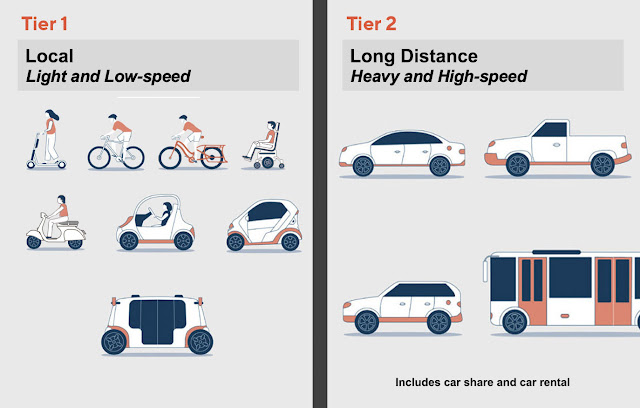Two-tier mobility
By Steve Price
The concept of “two-tier mobility” attempts to impose discipline on America's mobility habits, but in a way that acknowledges the value of full-size cars while being more discerning about their use in daily living. Tier 1 vehicles are bicycles, scooters, mopeds, neighborhood electric vehicles (NEVs), and an emerging class of small, autonomous shuttles transporting 8 to 12 passengers at slow speeds. Over 71 percent of travel in America is within a radius of 8 miles or less. This sweeps out an accessible area of over 200 square miles, depending on geographic constraints. Within this nearby but generous zone, seeking out a freeway for travel doesn't save much time.
Some Tier 1 vehicles, such as e-mopeds and NEVs, can easily handle traveling 8 miles and back. About two-thirds of travel is 5 miles or less, which is easily done by bicycle. At 12 to 15 mph, that would be 20 to 25 minutes by e-bike, which encompasses an area of 78.5 square miles. What is the lion’s share of travel for? A moment’s reflection describes Americans’ destinations: drug store, hair salon, medical appointment, groceries, bank, post office, coffee shop, movie theater, library, dinner with friends, bookstore, etc. What is the common denominator of these destinations? For most homes, they are not far away.
This is not to deny the value of Tier 2 vehicles; many people require them daily, including home health care workers who care for a widely dispersed clientele, the infirm who need to be driven, traveling professionals who need a lockable vehicle for equipment and papers, day laborers, and construction workers. For others, getting out of town occasionally for a trip to the mountains or the coast enriches life. Yet we don't need a 2-ton vehicle for every conceivable trip.
To read further about two-tier mobility, check out my article in Public Square, the journal of the Congress for the New Urbanism, “Traveling near and far toward low-carbon cities.”


